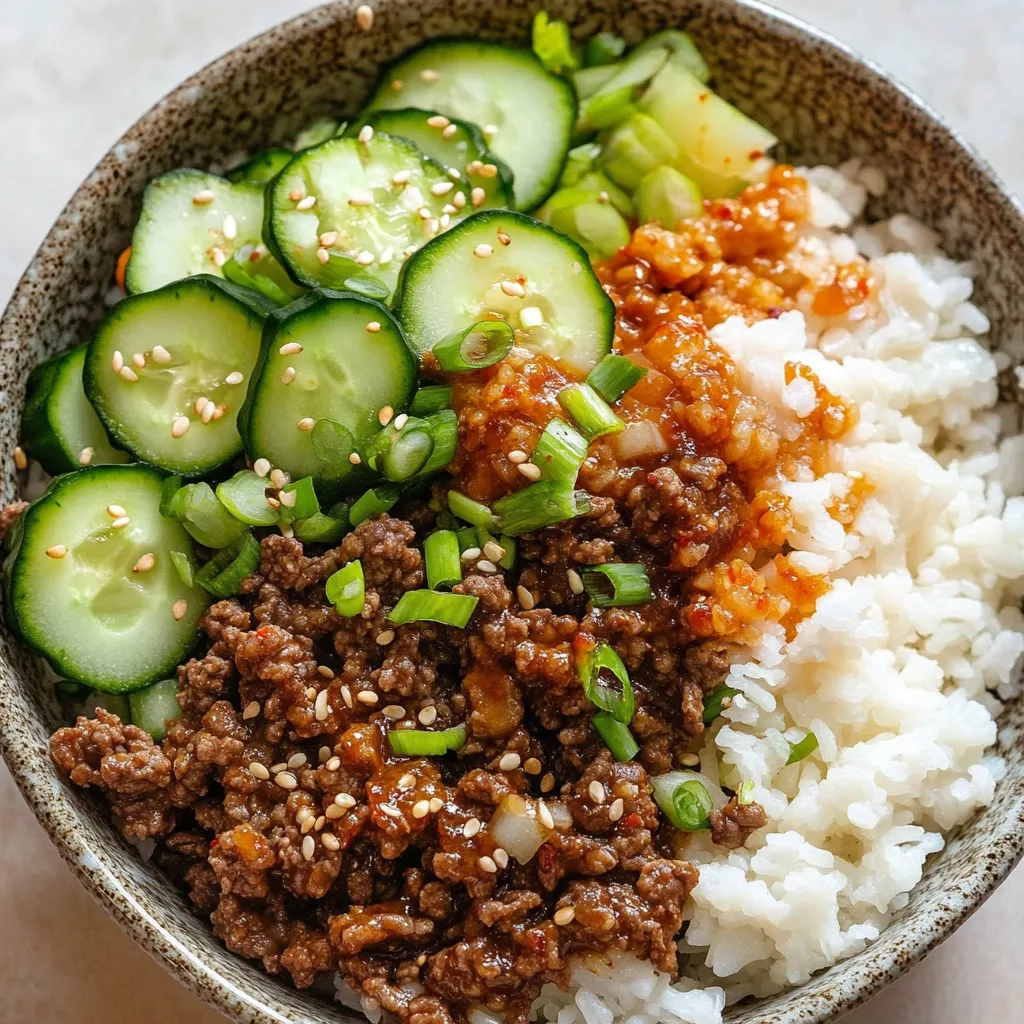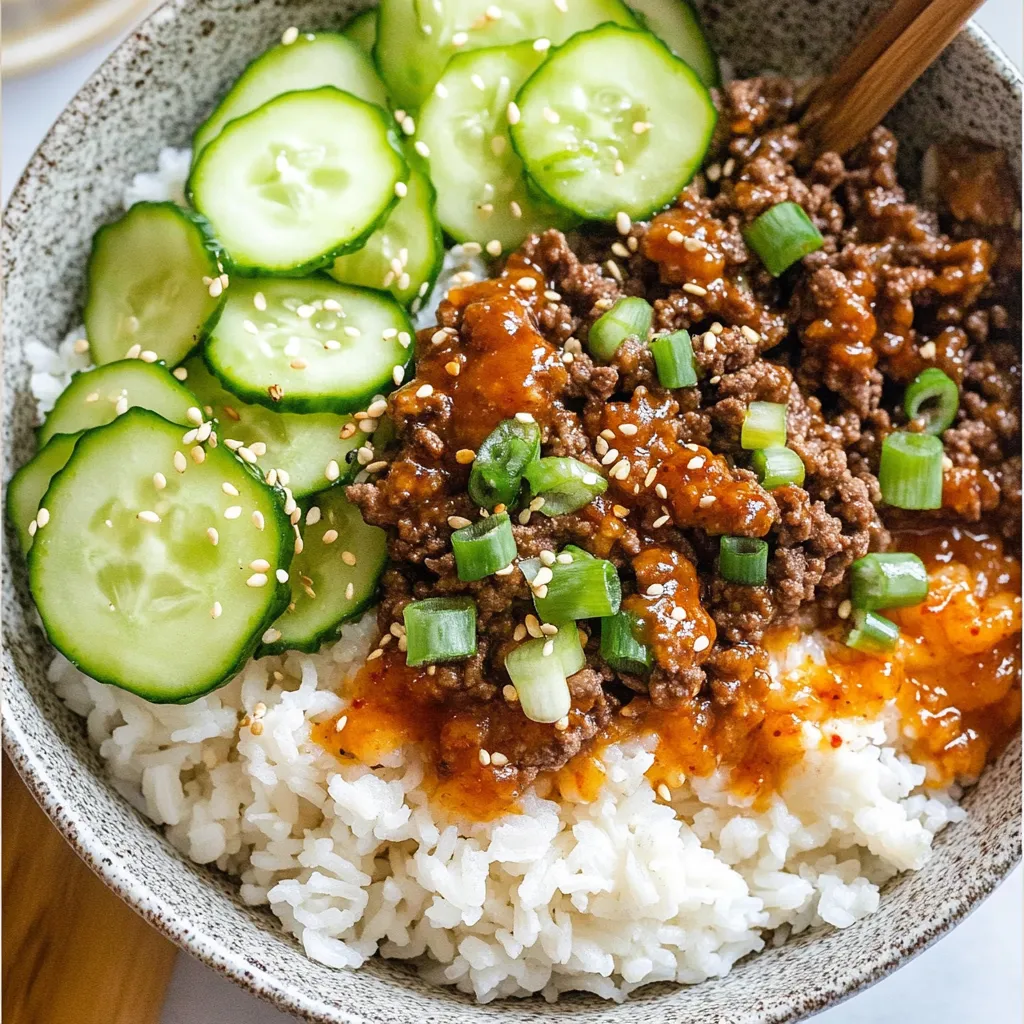 Pin it
Pin it
The humble, savory comfort of Korean-inspired beef comes alive in this quick weeknight wonder. Ground beef simmered in a perfect balance of soy, ginger, and garlic creates an irresistible base for a bowl that brings restaurant flavors right to your family table. Served over steaming rice with cool cucumber slices and spicy-sweet gochujang sauce, this 30-minute meal delivers authentic Korean flavors without requiring specialty ingredients or complicated techniques.
I stumbled upon this recipe when craving Korean food but living too far from any restaurants. My first attempt won over my husband who typically wrinkles his nose at "adventurous" meals. Now it's in our regular rotation, with my children specifically requesting "that Korean beef thing" at least twice a month!
Ingredients That Make All The Difference
- Low-sodium soy sauce: Controls the saltiness while providing rich umami depth. Regular soy sauce works in a pinch but might make the final dish too salty, so adjust other seasonings accordingly.
- Fresh ginger: Provides that distinctive warmth and subtle spice that defines Korean cuisine. Store your ginger root in the freezer and grate it (skin and all) while still frozen—it's easier to work with and lasts practically forever.
- Gochujang: This Korean chili paste is what transforms this dish from good to authentically amazing. The complex sweet-spicy-umami flavor can't be replicated with other hot sauces. Look for it in the international section of most supermarkets.
- Brown sugar: Balances the saltiness of the soy sauce and heat from the pepper flakes. Dark brown sugar adds a deeper molasses note that complements the beef beautifully.
- English cucumber: Provides essential freshness and crunch. The seedless variety doesn't need peeling and won't water down your dish like regular cucumbers might.
Step-by-Step Instructions
- Begin by preparing your Korean beef sauce. In a medium bowl, whisk together the low-sodium soy sauce, water, light brown sugar, sesame oil, and crushed red pepper flakes until the sugar completely dissolves. This balance of salty, sweet, nutty, and spicy forms the foundation of authentic Korean flavor. Set this mixture aside while you cook the beef, allowing the flavors to meld together.
- Heat a large skillet over high heat. When the pan is thoroughly hot (you can test by flicking a few drops of water—they should immediately sizzle and evaporate), lightly spray with cooking oil. Add the ground beef, breaking it into small pieces with a wooden spoon. Let the meat brown undisturbed for about a minute before stirring to develop richer flavor through caramelization. Continue cooking for about 4 more minutes until the beef is no longer pink, breaking it into smaller pieces as it cooks.
- Once the beef is browned, reduce the heat to medium and add the finely diced onion, minced garlic, and grated ginger to the skillet. These aromatic ingredients will infuse the meat with classic Korean flavors. Stir constantly for about one minute, until you can smell the garlic and ginger becoming fragrant. Be careful not to burn the garlic, as it can become bitter.
- Pour your prepared sauce into the skillet, stirring to coat the meat mixture thoroughly. Bring the liquid to a simmer, then reduce the heat to low. Allow the mixture to simmer gently for 10 minutes, stirring occasionally. During this time, the sauce will reduce slightly and intensify in flavor, while the beef absorbs all those wonderful seasonings. The finished mixture should be moist but not swimming in liquid.
- While the beef is simmering, prepare your rice according to package directions. For convenience, microwave frozen brown rice packets, or use freshly cooked white or brown rice. The neutral flavor of rice provides the perfect canvas for the flavorful beef mixture. Slice your cucumbers thinly, creating refreshing, crisp pieces that will add textural contrast to the dish.
- To assemble your Korean beef bowls, start with a base of rice in each serving bowl. Top with a generous portion of the simmered beef mixture. Arrange sliced cucumbers alongside the beef, then add a dollop of gochujang sauce. The amount depends on your heat preference—start conservatively if you're new to gochujang, as its spiciness can be intense. Finish by sprinkling with sesame seeds and sliced green scallions for a pop of color, texture, and freshness.
 Pin it
Pin it
I discovered a trick with the gochujang sauce that transformed this dish—mixing a small spoonful with a few drops of water creates a drizzling consistency that distributes the flavor more evenly. My daughter, initially hesitant about "spicy" food, now happily adds her own gochujang drizzle, gradually building her tolerance for this wonderful Korean staple.
Perfect Balance of Flavors
What makes Korean cuisine so distinctive is its perfect harmony of five key flavor elements: salty (soy sauce), sweet (brown sugar), spicy (gochujang and pepper flakes), bitter (sesame), and umami (beef and fermented gochujang). This balance creates depth that satisfies on multiple levels and explains why this simple dish feels so complete and satisfying despite its straightforward preparation.
Family-Friendly Adaptation
While authentic Korean beef dishes might pack significant heat, this recipe allows for easy customization for different palates. I serve the beef mixture with minimal red pepper flakes, then provide various toppings—extra gochujang for heat-lovers, sliced avocado for creaminess, and even pineapple chunks for kids who enjoy a sweeter profile. This build-your-own-bowl approach has made this dish a unanimous family favorite.
Meal Prep Champion
This recipe shines in meal prep scenarios. I often double the beef mixture on Sunday, storing portions in glass containers alongside cucumber slices (kept separate until serving). Throughout the week, I'll microwave the beef and rice together, then add fresh toppings for a home-cooked meal that takes just minutes to assemble—perfect for busy weeknights when cooking from scratch feels impossible.
I've come to treasure this Korean beef recipe as more than just a meal—it's become my gateway to exploring international flavors with my family. There's something profoundly satisfying about recreating beloved restaurant dishes at home, especially when they bring such joy to the dinner table. Each time I make this, I'm reminded that good cooking doesn't always require exotic ingredients or complicated techniques—sometimes it's just about combining simple elements in harmony and sharing them with the people you love.
Frequently Asked Questions
- → Can I use ground turkey instead of beef?
- Yes, you can substitute lean ground turkey, chicken or pork. For vegetarians, crumbled tofu or plant-based meat alternatives work well too.
- → What is gochujang sauce?
- Gochujang is a Korean red chili paste that has a sweet, spicy and slightly fermented flavor. You can find it in most grocery stores in the international food section.
- → Is this recipe gluten-free?
- This recipe can be gluten-free if you use gluten-free soy sauce and check that your gochujang sauce is also gluten-free.
- → What can I serve with Korean beef bowls?
- Korean beef bowls are a complete meal, but you could add kimchi, pickled vegetables, or a simple side salad to round out your dinner.
- → Can I meal prep these Korean beef bowls?
- Yes! The beef mixture keeps well for 3-4 days in the refrigerator. Store the beef, rice, and toppings separately, then reheat and assemble when ready to eat.
